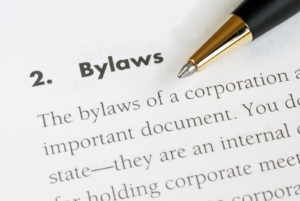Amend bylaws or revise bylaws?
A reader contacted us to find out how to tackle a number of changes needed for his bylaws. He was uncertain as to how to go about it and felt intimidated by the task. While it’s true that almost everyone hates bylaws (attorneys and parliamentarians are the exception), it is possible to change them without too much grief. Here we discuss the ordinary approach – to amend bylaws – and another alternative – to revise bylaws.
Amend bylaws
The process to amend bylaws is usually given within the bylaws themselves. Typically there are some requirements to keep it from being too easy. Since bylaws are a contract between the organization and its members, it isn’t desirable to be able to modify the terms any old time that you feel like it.
I have seen nonprofit bylaws that allow the board to amend them at any meeting, by a majority vote – in other words, meeting just the ordinary standard for action. I have also seen the unhappy consequences, when people got carried away and made changes in haste that they later repented at leisure. If your board is amending bylaws several times a year, something is wrong. We recommend taking a longer view. Invest some time and thought into the issues to avoid flipping and flopping.
Usually notice is required—letting people know in advance what is planned. This is just common sense for changes to the organization’s key governing document. And typically it takes a two-thirds vote to amend bylaws. If your members have the right to amend the bylaws, rather than the board, the process will take longer and be more demanding.
Finally, when your body meets to vote on the bylaws, it is bound by “scope of notice.” It can make changes to the proposed amendments, but only within the parameters that were given in the notice.
Revise bylaws
If you have many changes to be made, a better approach might be to revise your bylaws. A small committee studies the bylaws, incorporates the desired changes, and presents a whole new document to the board or members. You will want to provide explanations of what has been changed, so that the voters are fully informed.
The advantage—and the threat!—of this approach is that any and all changes to the proposed document can be made at the meeting itself. If the group decides that it wants to go further than the original committee and be more drastic, it is perfectly free to do so. If your board or members are sensible and thoughtful folks, this won’t be a problem. But a wild-eyed faction could radically alter your organization on the spot, if they convinced enough people of their views. A revision is adopted by the same vote that is required to amend the bylaws, usually two-thirds of those voting.
Amend bylaws yourself
While it is essential to have good legal counsel to review what you’re up to, we think it’s best for a committee of the organization to draft the proposed amendments or a revision. It is critical that you understand and value your bylaws. This is a working document that you own. The best way to do that is to roll up your sleeves and do the line-by-line work of reading and changing. It won’t be as awful a task as it appears, and you’ll be happy you did.
After amending bylaws, secretary must…
Once you’ve amended your bylaws, there are some important steps to take. Read our blog entry on this topic to learn about these steps so you can do your due diligence, and take care of them.



Can a Presiding \officer present changes in the By-Laws of an \organization without a committee?
DeNelda, it’s going to depend on what the bylaws themselves say. Customarily, the bylaws will have an article called “Amendment.” That will describe how changes should be presented and adopted. If there is no such article in the bylaws, a presiding officer can make suggestions to whichever body has responsibility. Usually the body with responsibility with be EITHER the members, OR the board of directors. They will make the decision.
Hope this helps!
I belong to a non-profit board that occasionally goes into a closed executive session to “discuss personnel matters.” Members of the organization are asked to leave while the board discusses the issue privately. Any votes that are required during this discussion are taken in an open session that anyone can attend.
Nothing in our bylaws allow for a closed session. Nothing prohibits them. I have suggested that our bylaws explicitly outline what circumstances allow for such action. Some board members say they prefer to have the flexibility to decide what constitutes an issue requiring private discussion. While this practice is rare and in my view has not been abused, it strikes me that for the sake of transparency that we make this explicit. What do other boards do?
David, for a private nonprofit board, if this practice is rare and has not been a problem, I am in favor of keeping the flexibility of letting the board decide when to go into “executive session.”
In general, we need rules when people have trouble figuring out what the organization’s values are. Sounds to me as though your folks are clear and act according to their values.
Of course if you were a public body, it would be an entirely different situation. Or if there is controversy about transparency, then you might wish to work on this issue.
Hope this helps! Thanks for writing – Ann
Regarding Bylaws: When is it a revision and when is it an amendment
Eileen, when you “amend,” you keep the bylaws as they are and change a smallish portion. When you “revise,” you prepare a whole new text in which everything can be different.